
The Russell Company Upper Mill is an historic structure in Middletown, Connecticut, at the junction of Russell Street and East Main Street in South Farms, at the end of East Main Street's commercial and industrial development areas. Built in 1836, it is listed on the National Register of Historic Places. There is a small pond to the south. Small businesses border the street to the north, followed by the buildings of Russell Manufacturing Company, the area's most dominant feature. Russell Street crosses Sumner Brook nearby and ascends to a large residential district to the west. The mill is currently a condo-apartment complex.

The Schiller Piano Company was an American manufacturer of pianos in Oregon, Illinois. It operated independently from 1890 to 1936, when it merged with the Cable Company and thereafter produced pianos under the name Cable and Conover. Thousands of pianos were produced in its factory, which was operated by corporate successors until 1971. The 120,000-square-foot (11,000 m2), stucco-clad building was renovated for use as an indoor mall in 1975 and today operates as the Conover Square Mall.
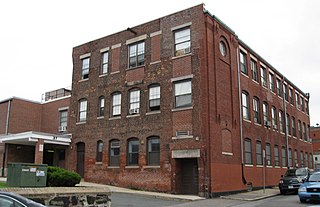
The Berger Factory is a historic factory building at 37 Williams Street in Boston, Massachusetts. Built in 1902, it was home to one of the nation's first manufacturers of precision engineering and surveying instruments, and a surviving example of Roxbury's late 19th-century industrial development. It was listed on the National Register of Historic Places in 1980, and now houses residences.

The Dorchester-Milton Lower Mills Industrial District is a historic district on both sides of the Neponset River in the Dorchester area of Boston and in the town of Milton, Massachusetts. It encompasses an industrial factory complex, most of which was historically associated with the Walter Baker & Company, the first major maker of chocolate products in the United States. The industrial buildings of the district were built between about 1868 and 1947. They were listed as part of the district on the National Register of Historic Places in 1980, with a slight enlargement in 2001. The buildings have been adapted for mixed industrial/retail/residential use.

The F.W. Smith Silver Company is a historic factory building at 60 Chestnut Street in Gardner, Massachusetts. It was built in 1892 by Frank W. Smith, who had begun manufacturing sterling silver silverware in 1886. The business continued under a succession of owners until 1958. The building is locally distinguished for its late Victorian commercial style, including a tower with pyramidal roof, and stained glass windows. The building was listed on the National Register of Historic Places in 1979.
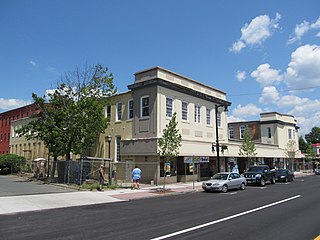
The United States Whip Company Complex or "United States Line Company Complex" is a historic factory located in Westfield, Massachusetts. It was owned and operated by one of the whip-making businesses that led Westfield to become widely known as "Whip City". United States Whip, created in 1892 by the consolidation of several local manufacturers, was the world's largest manufacturer of whips. The factory complex was listed individually on the National Register of Historic Places in 1983, and as part of an expanded Westfield Center Historic District in 2013.
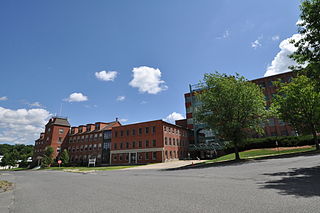
The Eaton, Crane & Pike Company Factory, once the Terry Clock Company Factory is a historic former factory complex in Pittsfield, Massachusetts. Developed over a period of years between 1883 and 1967, the complex was home to one of Pittsfield's major paper concerns, and a significant local employer. Now converted to mixed residential and light industrial use, it was listed on the National Register of Historic Places in 1990.

The Haverhill Board of Trade Building is a historic factory building at 16-18 and 38-42 Walnut Street in Haverhill, Massachusetts. The seven-story brick building was built in stages between 1906 and 1908 by the Haverhill Board of Trade, a consortium of local businessmen. The purposes of the building was to provide affordable factory space to small business operators, principally in the shoe manufacturing business that dominated Haverhill's economy in the early 20th century. The building also marked an expansion of Haverhill's business and industrial district into a previously residential area. The building was listed on the National Register of Historic Places in 2007. It has been converted to residential use.

The Arlington Gaslight Company is an historic industrial complex in Arlington, Massachusetts. It is one of the town's few large-scale examples of industrial architecture, built for a local fuel company in 1914. The three-building facility presently houses the town's public works department with the Gas Light Company Building housing the town's Facilities Department. It was listed on the National Register of Historic Places in 1985.
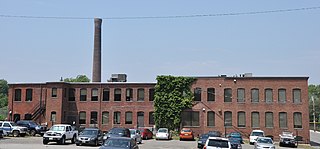
The American Watch Tool Company is a historic factory complex at 169 Elm Street in Waltham, Massachusetts. The company was founded in 1877 as a spin-off from the successful American Watch Company, and was used for the production of watchmaking tools until 1904. The four-building complex traces the evolutionary history of this business. The factory was listed on the National Register of Historic Places in 1989.

The United States Watch Company is a historic factory complex at 260 Charles Street in Waltham, Massachusetts. Built in 1886 and enlarged in 1901, it represents one of the most successful spinoffs of the American Waltham Watch Company, Waltham's dominant watchmaker of the late 19th century. When the complex was listed on the National Register of Historic Places in 1989, it was the last watch factory left in the city.
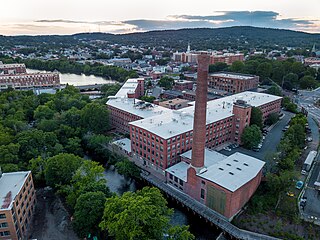
Charles River Museum of Industry & Innovation is a museum of the American Industrial Revolution located on the Charles River Bike Path, near the intersection of the Charles River and Moody Street in Waltham, Massachusetts. It houses and displays machinery and artifacts of the industrial revolution from the nineteenth and twentieth centuries. The building was originally built as part of the Boston Manufacturing Company, Francis Cabot Lowell's seminal, fully integrated textile mill. The museum, which was incorporated in 1980 and opened to the public in 1988, takes up only a small portion of the previous mill building complex.

The Crescent Warehouse Historic District is a 10.5-acre (4.2 ha) historic district in Downtown Davenport, Iowa, United States. The district is a collection of multi-story brick structures that formerly housed warehouses and factories. Most of the buildings have been converted into loft apartments. The district was listed on the National Register of Historic Places in 2003.

The Jarvesville Historic District of Sandwich, Massachusetts is a predominantly residential historic district centered on the site of the former Boston and Sandwich Glass Company factory. It is located north and east of Sandwich Center. Although the area has buildings that date to the middle of the 18th century, most of the district's more than 200 contributing properties are residences built between 1825 and 1860, when the glass company was at its height. These houses are predominantly Cape and Greek Revival in character, and are modest one- and two-family buildings that originally housed glass factory workers.
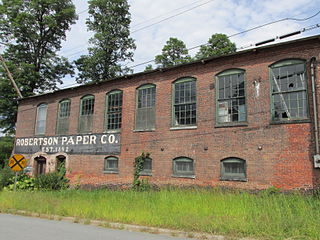
The Robertson Paper Company Complex was a historic industrial facility on Island Street in Bellows Falls, Vermont. It consisted of a collection of mostly-interconnected factory and related buildings, built between c. 1890 and c. 1960 by various paper-related companies. It was occupied and enlarged by the Robertson Paper Company between 1907 and its failure in 1987, at which time it was the longest-lived paper company in the state. The complex was listed on the National Register of Historic Places in 1990. It was demolished in 2018-19 as a Brownfields Economic Revitalization Alliance (BERA) project, with federal, state, and local funding.

Sohmer and Company Piano Factory is a historic piano factory located in the Astoria neighborhood of Queens, New York City. It was built in 1886 by Sohmer & Co., and is a six-story, L-shaped, Rundbogenstil / Romanesque Revival style brick building. The corner features a clock tower with a copper trimmed mansard roof. The building was expanded about 1906–1907. It was converted to residential usage starting in 2007.

The Richmond Underwear Company Building is a historic industrial facility at 65 Millet Road in Richmond, Vermont. Built in 1900, it was the town's first major industrial facility, bringing an economic boom to the town. The factory was used for the manufacture of underwear until 1946, and has seen a variety of industrial and commercial uses since then. It was listed on the National Register of Historic Places in 1992.

The Commercial Exchange Building, also known as the Collins Manufacturing – Jackson Automobile Company complex, is an industrial building complex located at 2301 E. Michigan Ave. in Jackson, Michigan. The building was built partly in 1895, and was listed on the National Register of Historic Places in 1993. The listing included four contributing buildings.

The Leonard, Shaw & Dean Shoe Factory is a historic industrial property located at Rice and Peirce Streets in Middleborough, Massachusetts. Built in 1896 and repeatedly enlarged before 1911, it was home to one of the town's major employers. Now converted to residential use, the factory complex was listed on the National Register of Historic Places in 2018.

The American Optical Company Historic District encompasses a historic industrial complex on the Quinebaug River in Southbridge, Massachusetts. Located on roughly 80 acres (32 ha) east of downtown Southbridge, the complex was developed between the 1880s and 1950s by the American Optical Company (AO), one of the largest manufacturers of eyewear at the turn of the 20th century. The district was listed on the National Register of Historic Places in 2023.






















